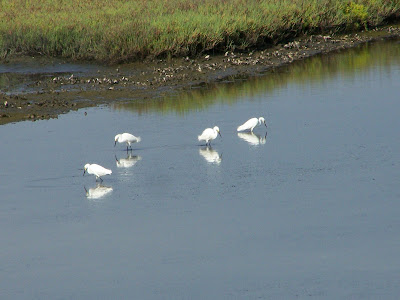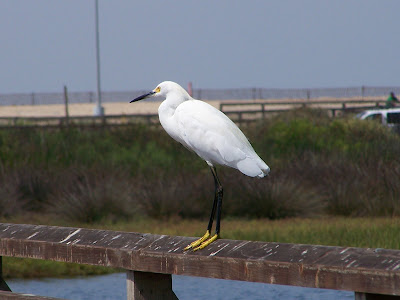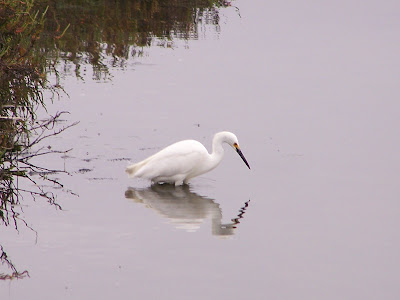
The Snowy Egret is one of our most common egrets. Common it may be, but it is a pretty bird with lacy plumes and a crest that it raises when it thinks its territory is being invaded. You can find Snowies any place you find fish. It likes estuaries, tidal marshes, wetlands, streams and rivers, ponds, lakes, and any body of water with fish. I have seen them at Bolsa Chica, Huntington Central Park, San Joaquin Wildlife Sanctuary, Carr Park, Craig Park, Upper Newport Bay, and many more places. Here is a Snowy Egret fishing. Notice the little rings around him. He was shuffling his feet to flush out the prey. This action created concentric circles, ever widening rings around him as he fished.
Here is a Snowy Egret fishing. Notice the little rings around him. He was shuffling his feet to flush out the prey. This action created concentric circles, ever widening rings around him as he fished.
One of the liveliest egrets is the Snowy Egret. Smaller than the Great Blue Heron, and the Great Egret , it makes up for its small stature with an aggressive feisty manner. Its active feeding style is rivaled only by the Reddish Egret's frenetic dash across the shallows.
 Snowies often hang out together or with other Egrets and Herons.
Snowies often hang out together or with other Egrets and Herons.

Birders often call this little, white egret a Snowy, or plural Snowies. Snowies were hunted for their plumes which are showy and pretty and were at one time endangered. They have bounced back now and are doing well.
Flying in.
Snowies are fun to watch because they are often so lively. They have yellow feet and juveniles have a yellow line down the back of their legs. In summer and fall, some immatures have lighter bills and legs. They also have a black bill.
Fishing in deeper water.
Snowies eat fish and invertebrates found in the water. They are found in mixed salt and fresh water and fresh-water environments.
 A Trio: Snowy Egret (left), Great Egret (center), and Great Blue Heron (right). From Shortest to tallest.
A Trio: Snowy Egret (left), Great Egret (center), and Great Blue Heron (right). From Shortest to tallest.Above are three very common Egrets and Herons. The Snowy and the Great Egret are both white, but the Snowy is much smaller, has a black bill, and yellow feet. It is also a much livelier hunter. The Great Egret moves slowly and strikes fast. The Snowy is often agitated and all over the place. The Great Blue Heron is very different looking--not white and slow moving like the Great Egret. Great Blue Heron is very large, blue-gray, and has black markings on its face. The Snowy is often mistaken as the Great Egret's baby when they are together, but they are both adult birds.
Great Egret and Much Smaller Snowy Egret Below left.


And note the very different Great Blue Heron above, right.
One of the few other small white egrets or herons that are seen in this area that a Snowy might be confused with is the Cattle Egret. The Cattle Egret is smaller and stouter. It has shorter legs, black feet, and an orange bill --unlike Snowy. Compare below. Also, the Cattle Egret eats insects stirred up by mammals in grassy areas. They are not likely to be in the same type of environment, but on occasion, it could happen. The Snowy is long-legged and slender and is taller than other small egrets and herons in this area.
Cattle Egret Below, Courtesy US Fish and Wildlife Service


The svelte Snowy Egret on Bolsa Chica Bridge with his yellow feet showing, above. Note how much longer the Snowy's legs are.
 Thinking over his next move, a Snowy stands on the shore at Bolsa Chica Ecological Reserve.
Thinking over his next move, a Snowy stands on the shore at Bolsa Chica Ecological Reserve.Average sizes of Herons and Egrets in Orange County--does not include leg length which can make a difference:
Great Blue Heron Length 46" Wing Span 72"
Great Egret Length 39" Wing Span 51"
Snowy Egret Length 24" Wing Span 41"
Cattle Egret Length 20" Wing Span 36"
Green Heron Length 18" Wing Span 26"
Black-crowned Night Heron Length 25" Wing Span 44"
There are many types of egrets and herons in Orange County. Next time you go out birding near a lake, pond, stream be on the look out for the feisty little Snowy Egret.
Shake a Leg from OC Birder Girl on Vimeo.
Snowy Links
If You Build It, They Will Come
Bold plan by the US Fish and Wildlife Service in the Chesapeake Bay to attract Snowy Egrets back to Poplar Island. Find out what they did, and if it worked.
US Geological Service: Snowy Egret
Short profile of the Snowy Egret.
Birder's World Photographer Karen Lund: Snowy Egret
Great shot a Snowy by Karen Lund.
Cornell's All About Birds
Usual detailed article.
Animal Diversity Web: Snowy Egret
Detailed article.

Photographs
Smithsonian Institution: Nature's Best 2007--Snowy Egret Photo
Good photo of two Snowies.
Vireo Photographs: Snowy Egret
Video
Internet Bird Collection
Snowy Egret videos. Good videos showing Typical Snowy Egret Behavior.
Home - Index - Contact - Shop
See OC Birder Girl Store on Amazon.
Subscribe to My Birding Blog: Posts (Atom)















No comments:
Post a Comment